Antique Brass Persian Bedouin Astrolabe. Signed
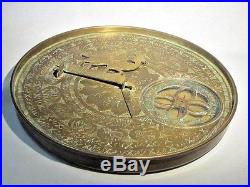
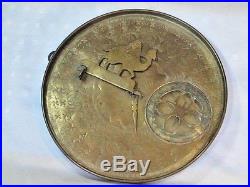
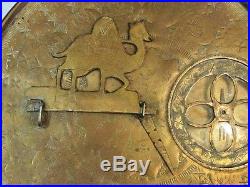
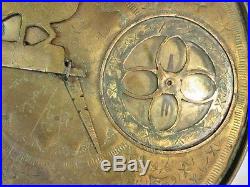


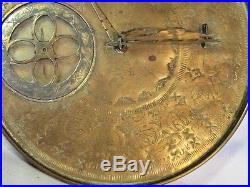
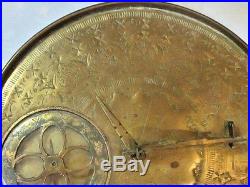
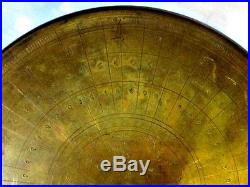
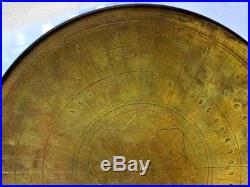
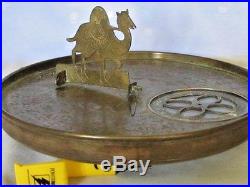
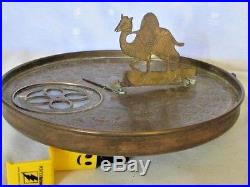

Offered for sale is this outstanding Antique Brass Persian Bedouin Astrolabe, being 8 1/4 in diameter, signed by the maker with zodiac engraving all over the front and back of this instrument. There is a recessed compass in the instrument. Historically, each Bedouin Tribe Master had one of these astrolabes to help him navigate either on land or in water. The astrolabe measures 8 1/4 in diameter. The Persian Bedouin Astrolabe is a historical astronomical instrument used by classical astronomers and astrologers. Brass astrolabes were developed in much of Persia (Iran), chiefly as an aid to navigation and as a way of finding the qibla, the direction of Mecca. In the Islamic world, astrolabes were used to find the times of sunrise and the rising of fixed stars, to help schedule morning prayers.
It was the chief navigational instrument until the invention of the compass and sextant. Its many uses included locating and predicting the positions of the sun, moon, planets and stars; determining local time given the local longitude and vice-versa; surveying, and triangulation.
Astrologers of European nations used astrolabes to construct horoscopes. In the Islamic world, they are and were used primarily for astronomical studies, though astrology was often involved there as well. An astrolabe (Greek: astrolabos, "star-taker")[1] is an elaborate inclinometer, historically used by astronomers, navigators, and astrologers. Its many uses include locating and predicting the positions of the Sun, Moon, planets, and stars, determining local time given local latitude and vice-versa, surveying, triangulation, and to cast horoscopes. It was used in classical antiquity, the Islamic Golden Age, the European Middle Ages and Renaissance for all these purposes.In the Islamic world, it was also used to calculate the Qibla and to find the times for Salat, prayers. There is often confusion between the astrolabe and the mariner's astrolabe. The mariner's astrolabe was developed to solve these problems.
The origins of the astrolabe were in classical Greece. 225 BC, the great codifier of conic sections, probably studied the astrolabe projection. The most influential individual on the theory of the astrolabe projection was Hipparchus who was born in Nicaea in Asia Minor (now Iznik in Turkey) about 180 BC but studied and worked on the island of Rhodes. Hipparchus, who also discovered the precession of the equinoxes and was influential in the development of trigonometry, redefined and formalized the projection as a method for solving complex astronomical problems without spherical trigonometry and probably proved its main characteristics. Hipparchus did not invent the astrolabe, but he did refine the projection theory. The earliest evidence of use of the stereographic projection in a machine is in the writing of the Roman author and architect, Marcus Vitruvius Pollio ca.26 BC, who in De architectura describes an anaphoric clock (probably a clepsydra or water clock) in Alexandria. The clock had a rotating field of stars behind a wire frame indicating the hours of the day. The wire framework (the spider) and the star locations were constructed using the stereographic projection.
Similar constructions dated from the first to third century and have been found in Salzburg and northeastern France, so such mechanisms were apparently fairly widespread among Romans. The Astrolabe in Islam: The astrolabe was introduced to the Islamic world the mid-eighth century. The astrolabe was fully developed during the early centuries of Islam.Arab treatises on the astrolabe were published in the ninth century and indicate a long familiarity with the instrument (the oldest existing instruments are Arabic from the tenth century, and there are nearly 40 instruments from the 11th and 12th centuries). The astrolabe was inherently valuable in Islam because of its ability to determine the astronomically defined prayer times and as an aid in finding the direction to Mecca (the qibla). It must also be noted that astrology was a deeply imbedded element of early Islamic culture and astrology was one of the principle uses of the astrolabe.
Persian astrolabes became quite complex, and some were genuine works of art. There are a number of interesting stylistic differences between astrolabes from the eastern Islamic areas (the Mashriq), Northern Africa (the Maghrib) and Moorish Spain (al-Andalus). The astrolabe was also used in Mughal India in a somewhat less elaborate style. The astrolabe was widely used in Europe in the late Middle Ages and Renaissance, peaking in popularity in the 15th and 16th centuries, and was one of the basic astronomical education tools.A knowledge of astronomy was considered to be fundamental in education and skill in the use of the astrolabe was a sign of proper breeding and education. Their primary use was, however, astrological. Astrology: Astrology has had a major influence on the history and development of astronomy.
The ancient astronomers were motivated to measure the positions of the stars and planets and to keep track of eclipses for astrological reasons the word "horoscope" is from the Latin horoscopium which, in turn, is from the Greek words for "boundary" (the horizon) and "target" (object of observation). Their terminology, measurements and techniques were the foundation for the astronomical knowledge that eventually evolved. Many old astrolabes had astrological features that would allow the user to determine horoscopes. Creating a horoscope requires knowledge of the positions of the planets and the ecliptic for a certain date and time.The astrologer interprets the aspects to advise his client. The astrolabe was a convenient way to determine a horoscope because much astrological stress was placed on the position of the ecliptic. Of particular interest were the ecliptic degree on the eastern horizon (the ascendant), the ecliptic degree on the western horizon (the descendent) and the ecliptic degree on the meridian (the degree of mid-heaven).
In use, the astrolabe is set to the time and date of interest birth, death, coronation, etc. And the ecliptic degrees are read directly. The astrolabe could be used to find the "house" occupied by a planet, but an ephemeris was required to find the planetary coordinates for a date. Provenance: Christies, May, 1997: From a private estate. Tomlinson:'Instruments of Navigation, London, 1958.
Of European Scientific Instruments in the dept. Of Medieval & Later Antiquities of the British Museum, London. Ref: Astrolabes of the World, Robert T. Please look at the picture and read the description, which form a part of the condition description. This product would make a wonderful addition to any scientific instrument, astrolabe or sundial collection when displayed in a prominent place, being a grand collectible item that would adorn any serious collector's prized scientific instrument and sundial accumulations, while showing a discriminating dedication for fine sundials and other scientific instrument items as well as a devotion to acquiring fine collectibles.
Please note that the photos form a part of the condition description. The item "Antique Brass Persian Bedouin Astrolabe. Signed" is in sale since Thursday, June 15, 2017. This item is in the category "Antiques\Asian Antiques\Middle East". The seller is "captainmadison" and is located in Washington Crossing, Pennsylvania.
This item can be shipped worldwide.
- Color: Brass
- Primary Material: Brass
- Featured Refinements: Persian Antiques
- Type: Bedouin Persian Astrolabe
- Age: Pre-1800
- Original/Reproduction: Antique Original
- Maker: Bedouin Astrolabe Maker
- Region of Origin: Middle East
